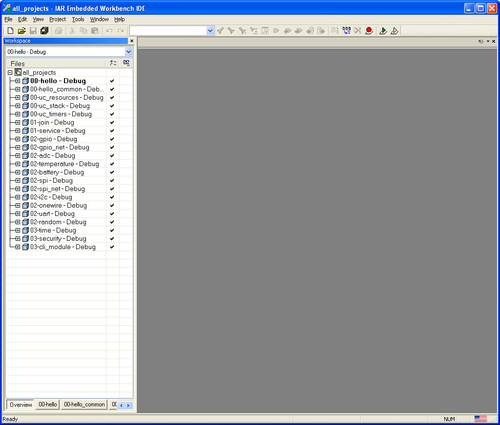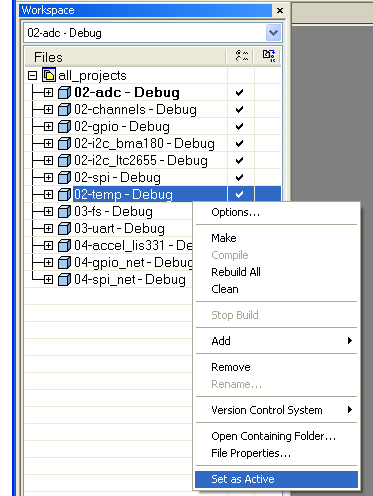all_projects.eww. Double-click on this file to open the workspace.
At this point we expect the IAR tool chain to be installed and set-up.
To verify its functionality, this section shows you how to build and load the sample applications on your board. These sample applications are described in detail in the Sample Applications later in this guide.
The contains an IAR workspace at
all_projects.eww. Double-click on this file to open the workspace.

The column on the left lists a number of IAR projects, each corresponding to a sample application. You can switch between projects by right-clicking on the project name you want, and choosing Set as Active.

To build a project, right-click on the project name and choose Rebuild All. IAR now executes the following steps:

Building configuration: 02-temp - Debug Updating build tree... 22 file(s) deleted. Updating build tree... cli_task.c temp_app.c dnm_cli_util.c dnm_cli.c dnm_local.c notification_task.c Linking ocfdk_02-temp.out Total number of errors: 0 Total number of warnings: 0 |
You have two options for loading your application onto your -based board.
To be able to debug your application, you need an in-circuit debugging probe. The projects have been set up for the j-link. |
This option is best suited when developing your application. It allows you to use on-chip debugging tools such as breakpoints and live watch. |




This procedure only loads the main executable. For the board to function correctly, you also need to load additional elements in flash (fuse table, partition table, loader). We recommend you follow the steps in the Programming Eterna Devices page once, after which you can replace the main executable multiple times using the procedure above. When reprogramming, IAR only replaces the main executable while other elements in flash (fuse table, partition table, loader) remain untouched. One side-effect is that, even if you replace the main executable, the file system remains untouched. If you had created files with a previous main executable, those files are still there after reprogramming the device using the procedure above. You can use the |
This option is best suited when you are done creating your application, and you want to deploy it on one or more motes without needing debugging capabilities. |
IAR is configured to output both an ELF and a binary file (see Installing the IAR Tool Chain).
You can use the tool to load this binary file as the main application by following the steps in the Programming Eterna Devices section.
This option replaces the entire flash image. This means that:
|